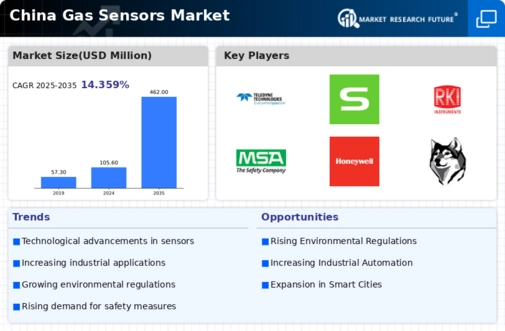Expansion of the Energy Sector
The expansion of the energy sector in China, particularly in renewable energy and natural gas, is significantly impacting the gas sensors market. As the country transitions towards cleaner energy sources, the need for effective gas monitoring systems becomes paramount. Gas sensors play a crucial role in ensuring the safe operation of energy facilities, including wind farms and natural gas plants. The market is projected to grow as energy companies invest in advanced monitoring technologies to enhance operational efficiency and safety. This trend suggests a promising future for the gas sensors market, with potential growth driven by the energy sector's evolution.
Industrial Growth and Urbanization
The rapid industrial growth and urbanization in China are driving the gas sensors market. As industries expand, the demand for monitoring air quality and detecting hazardous gases increases. Urban areas, with their dense populations and industrial activities, require effective gas detection systems to ensure public safety. The gas sensors market is projected to grow at a CAGR of approximately 8% from 2025 to 2030, reflecting the increasing need for safety measures in urban environments. Furthermore, the rise in construction activities necessitates the installation of gas sensors to monitor emissions and ensure compliance with environmental regulations. This trend indicates a robust market for gas sensors, as industries seek to enhance operational safety and minimize environmental impact.
Rising Industrial Safety Standards
The increasing emphasis on industrial safety standards in China is propelling the gas sensors market. Industries such as manufacturing, oil and gas, and chemicals are under pressure to comply with stringent safety regulations. The implementation of gas detection systems is becoming a necessity to prevent accidents and ensure worker safety. As a result, the gas sensors market is experiencing a notable uptick in demand, with estimates suggesting a growth rate of around 7% annually. Companies are investing in advanced gas sensors to meet regulatory requirements and enhance workplace safety, indicating a strong market potential driven by safety compliance.
Technological Integration in Smart Cities
The integration of advanced technologies in the development of smart cities is a key driver for the gas sensors market. China is investing heavily in smart city initiatives, which include the deployment of IoT-enabled gas sensors for real-time monitoring of air quality. These sensors provide critical data that can be used to manage urban environments more effectively. The gas sensors market is likely to benefit from this trend, as municipalities seek to implement smart solutions that enhance public safety and environmental monitoring. The anticipated growth in smart city projects could lead to an increase in the market size, with projections indicating a potential market value exceeding $1 billion by 2030.
Environmental Awareness and Sustainability Initiatives
Growing environmental awareness among the Chinese population is significantly influencing the gas sensors market. As citizens become more conscious of air quality and pollution, there is a heightened demand for gas detection technologies. The government has implemented various sustainability initiatives aimed at reducing emissions and improving air quality, which in turn drives the adoption of gas sensors in various sectors. The market is expected to witness a surge in demand for sensors that can detect volatile organic compounds (VOCs) and other harmful gases. This shift towards sustainability not only enhances public health but also aligns with China's long-term environmental goals, thereby fostering growth in the gas sensors market.


















Leave a Comment